When it comes to choosing a home, safety is a top priority. While many homeowners think about burglar alarms and security systems, one often overlooked aspect of home safety is fire resistance. Fires can spread quickly, destroying everything in their path, and sometimes the most unexpected fires occur. This makes it crucial to consider building materials that offer the best protection. Concrete, as a construction material, stands out as one of the most fire-resistant options available.
Fire Resistance in Construction
Fire resistance refers to a material’s ability to withstand fire or high heat without losing its structural integrity. Building materials are rated for fire resistance based on how long they can endure exposure to fire before they start to break down. Materials that have higher fire-resistance ratings provide more protection, allowing more time for occupants to escape and for fire responders to arrive.
When it comes to fire safety in homes, the materials used for construction play a crucial role. Wood, for example, is a highly combustible material that can ignite and spread fire rapidly. Concrete, on the other hand, is a non-combustible material that does not catch fire or burn. Concrete is naturally resistant to heat and fire, making it an ideal choice for those concerned with fire safety. The fire-resistance capabilities of concrete homes are not only beneficial during a fire but also offer long-term peace of mind for homeowners.
Why Concrete Is Naturally Fire-Resistant
Concrete is made from a mixture of cement, water, and aggregates such as sand, gravel, or crushed stone. When these materials are combined, they create a solid, dense structure that is naturally fire-resistant. The key to concrete’s fire resistance lies in its physical properties. Unlike wood, which is organic and can burn easily, concrete is inorganic and non-combustible. Concrete does not catch fire or spread flames like other materials, and it can withstand extreme temperatures for extended periods without being damaged.
Concrete can endure temperatures of up to 2,000 degrees Fahrenheit (1,093 degrees Celsius), depending on the mix and reinforcement used. This means that concrete walls, floors, and roofs can remain intact and maintain their structural integrity during a fire, providing crucial time for evacuation and firefighting efforts. This level of fire resistance is one of the main reasons why concrete homes are often favored in areas with higher risks of wildfires or other fire hazards.
Fire-Resistant Concrete Homes
Building a concrete home comes with numerous advantages, and one of the most significant is the protection it provides against fire. Concrete homes are far less likely to catch fire or suffer extensive damage in the event of a fire, compared to homes made from wood or other combustible materials. This increased level of safety is a major selling point for homebuyers and is becoming more important as wildfires and other fire-related disasters continue to affect communities.
In addition to offering better fire resistance, concrete homes can help prevent the spread of fire. Concrete walls and floors are able to contain a fire to the area where it started, preventing it from spreading to other parts of the home. This containment is vital for preventing significant property damage and for ensuring the safety of the people inside. In multi-story concrete homes, each floor can be considered a barrier against the spread of flames, providing even more protection for occupants.
The fire-resistant nature of concrete also means that fires are less likely to compromise the structural stability of the home. In wood-frame homes, a fire can quickly weaken the structural components of the building, leading to potential collapse. In contrast, concrete homes are much more resilient, as they can retain their strength even when exposed to extreme heat. This means that in the unfortunate event of a fire, concrete homes have a higher likelihood of standing and remaining habitable, reducing the chances of total loss.
Fire-Resistant Building Codes
In many regions, building codes and regulations are evolving to address the growing concern about fire safety. In areas prone to wildfires or other fire hazards, stricter building codes are being implemented to ensure that homes can withstand potential fires. Concrete homes are often seen as the ideal solution to meet these codes because of their inherent fire resistance.
As more communities adopt fire-resistant building codes, the demand for concrete homes is increasing. Homebuilders and developers who choose to build with concrete are not only meeting local building standards but also offering homebuyers a product that exceeds basic fire safety requirements. This trend is expected to continue as fire risks increase in certain regions, making concrete homes an attractive option for buyers who prioritize safety and long-term durability.
Concrete’s role in fire-resistant building codes also extends to reducing the need for additional fireproofing measures. While wood-framed homes often require the installation of fire-resistant coatings, materials, and treatments, concrete homes generally do not need these extra precautions. This helps reduce construction costs while still providing exceptional fire protection.
Wildfire-Prone Areas
In areas that are at risk of wildfires, the choice of building materials can make all the difference. Wood-frame homes, which are common in many parts of the world, are particularly vulnerable to wildfire damage. These homes can quickly ignite and burn down in the event of a wildfire, posing a significant risk to both property and lives. Concrete homes, on the other hand, offer a much safer alternative.
The ability of concrete to resist fire makes it an ideal choice for homes in wildfire-prone regions. Concrete walls and roofs act as a protective barrier against flying embers, which are a common cause of wildfire spreading to buildings. Since concrete is non-combustible, it does not catch fire from embers or other sources of ignition, providing a much higher level of protection. Homeowners in areas affected by wildfires can have greater peace of mind knowing that their concrete home is far less likely to be destroyed by a blaze.
In addition to the inherent fire resistance of concrete, homeowners in wildfire-prone areas can further enhance their protection by using fire-resistant windows, doors, and other materials. Concrete’s compatibility with these fire-resistant components makes it even easier to create a home that is fully prepared for the risk of a wildfire.
Insurance Benefits
When it comes to home insurance, the fire resistance of a home can have a significant impact on premiums. Insurance companies often offer lower rates for homes that are made from fire-resistant materials, as these homes are less likely to suffer extensive damage from a fire. Since concrete homes are highly resistant to fire, they are often eligible for reduced insurance premiums, which can translate into significant savings for homeowners over the long term.
Additionally, in areas where fire risk is a concern, concrete homes are considered a safer investment by insurance providers. This can make it easier for homeowners to secure insurance coverage and may also result in more favorable policy terms. As the awareness of fire safety increases, more insurance companies are recognizing the value of concrete homes and offering incentives to homeowners who choose this fire-resistant building material.
Property Value
The fire-resistant nature of concrete homes can also have a positive impact on property value. As more homebuyers prioritize safety and fire protection, homes built with concrete are becoming increasingly desirable. In fire-prone areas, a concrete home is seen as a more secure and long-lasting investment compared to a traditional wood-framed home. The added protection against fire and other disasters makes concrete homes a smart choice for buyers who are looking for peace of mind and long-term durability.
Moreover, the fire resistance of concrete homes can help preserve their value over time. In the event of a fire, concrete homes are less likely to suffer from significant damage, meaning they will require fewer repairs or rebuilding. This can help homeowners maintain the value of their property, even after a disaster. For investors, concrete homes represent a sound investment with less risk of depreciation, as the durability and fire resistance of concrete ensure that the property retains its value for years to come.
Unparalleled Protection
Fire safety is an essential consideration for any homeowner, and concrete homes offer unparalleled protection when it comes to resisting fires. With their ability to withstand extreme temperatures, prevent the spread of flames, and maintain structural integrity during a fire, concrete homes provide a high level of security for both residents and property. The growing awareness of fire safety, coupled with the increased risks of wildfires and other fire hazards, is driving more homeowners to choose concrete as their building material of choice.
At Batten Builders, we specialize in creating concrete homes that offer not only exceptional fire resistance but also long-term durability and energy efficiency. If you’re considering building a home that prioritizes safety, fire resistance, and peace of mind, we’d love to help you design and construct the perfect concrete home. Contact us today to learn more about how a concrete home can protect your family and your investment.





